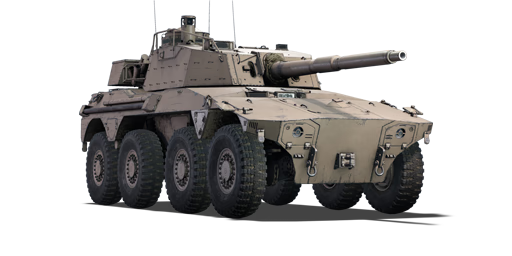




In 1976, the South African Armoured Corps issued a new project for a "New Generation Armoured Car", intended to replace the 4x4 Eland 90 in service as they were struggling to provide adequate support for the heavier Ratel IFVs in tank warfare. Following the inadequate performance of the initial prototype series, new specifications were issued, and new prototypes were designed by Sandock-Austral with assistance from German firm Thyssen-Henschel, leading to the light Class 1 ("Cheetah Mk1") and medium Class 2 ("Cheetah Mk2") fitted with a modification of the 76 mm OTO Melara naval cannon, as well as the heavy Class 3 ("Bismarck") fitted with a 105 mm L7. While the Class 2 was originally designed in two variants — the 2A having the engine at the front to allow a rear compartment for carrying infantry, and the 2B with a conventional rear-engined setup — such plans were later scrapped in favour of creating a vehicle more focused on reconnaissance and anti-tank capabilities, retaining the Ratel for the IFV role. The Class 2B prototype was selected for development, and limited production for further testing began in 1987, when it was christened the Rooikat. Mass-production began in mid 1990.
Introduced in Update 1.95 "Northern Wind", the Rooikat Mk.1D is a powerful and nimble light tank. It has excellent mobility, allowing it to easily set up ambush positions, flank, or reposition after sniping. While the gun somewhat lacks in post-penetration damage, the APFSDS shell's penetration is sufficient for even the heaviest opponents that it may face. Coupled with access to a two-plane stabiliser and laser rangefinder, the Rooikat excels in long range sniping, and can also perform well in closer range engagements, although it risks having to take multiple shots to take out a target.
| Ammunition | Type | Armor penetration (mm) at a distance: | |||||
|---|---|---|---|---|---|---|---|
| 10 m | 100 m | 500 m | 1000 m | 1500 m | 2000 m | ||
| APFSDS | 321 | 319 | 312 | 303 | 294 | 285 | |
| HE | 20 | 19 | 18 | 16 | 14 | 14 | |
| Belt | Belt filling | Armor penetration (mm) at a distance: | |||||
|---|---|---|---|---|---|---|---|
| 10 m | 100 m | 500 m | 1000 m | 1500 m | 2000 m | ||
| AP/T | 13 | 12 | 7 | 3 | 2 | 0 | |












Mobility | |
|---|---|
Protection |
|---|
Firepower | ||
|---|---|---|